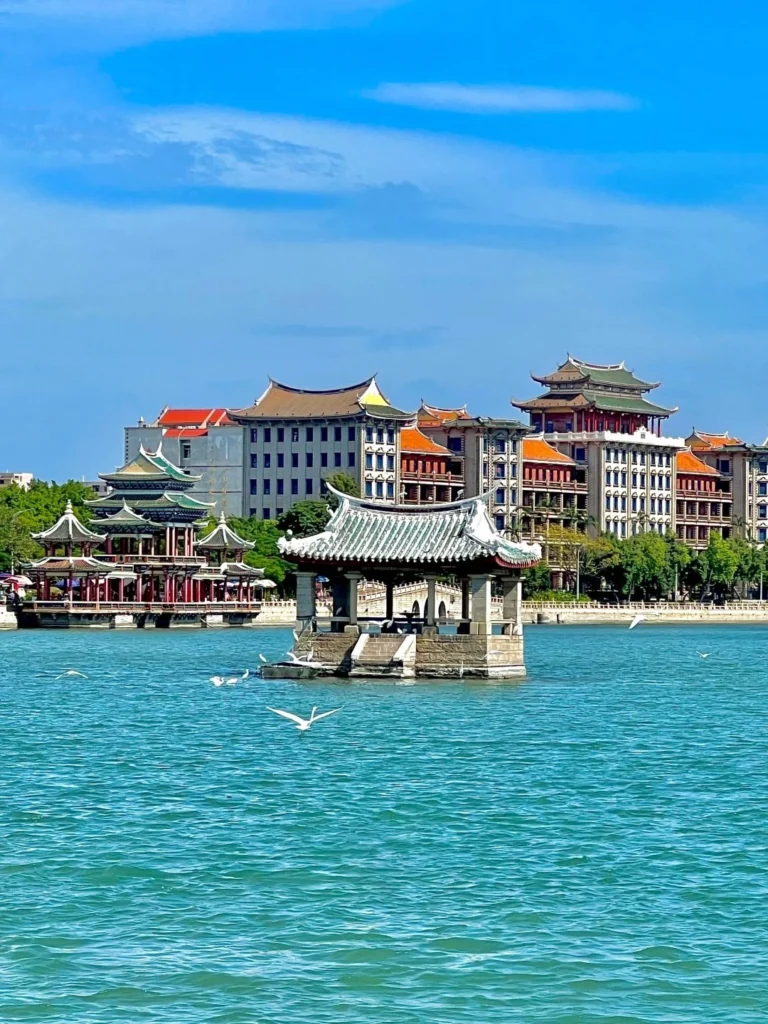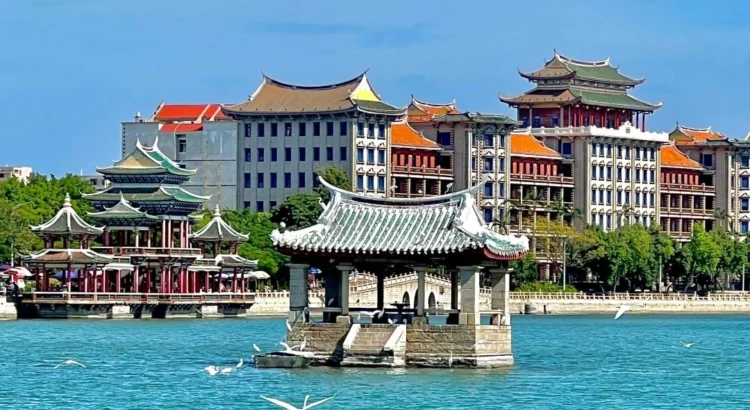
On the southeastern coast of China, cradled by the shimmering waters of the Taiwan Strait, lies Xiamen, a city that seamlessly blends the elegance of ancient Chinese heritage with the vitality of a modern coastal metropolis. Known for its breathtaking sea views, rich tea culture, and historic architecture, Xiamen offers travelers a multifaceted experience. Whether you are wandering through colonial-era streets, sipping oolong tea in a traditional teahouse, or enjoying the serenity of island landscapes, Xiamen reveals itself as one of China’s most graceful and welcoming destinations.
The Coastal Beauty Of Xiamen: Where City Meets Sea
Xiamen is, first and foremost, a coastal city. With its clean air, tree-lined boulevards, and island charm, it has earned the nickname “Garden on the Sea.” Much of Xiamen’s unique character stems from its geographical setting. As a port city with natural harbors, it has long served as a gateway between China and the world, and today, it welcomes visitors with the same open arms.
Gulangyu Island: A UNESCO World Heritage Jewel
Just off the main coast, a short ferry ride transports you to Gulangyu Island, a place where time seems to slow down. Gulangyu is a pedestrian-only haven filled with European-style villas, quiet pathways, and a charming blend of Chinese and Western architecture. Once home to consulates, missionaries, and wealthy merchants in the 19th century, it’s now recognized as a UNESCO World Heritage Site for its exceptional international cultural heritage.
Stroll along Piano Street, where melodies spill from open windows, or climb up Sunlight Rock, the island’s highest point, for panoramic views of the sea and Xiamen’s skyline. The island is affectionately known as “Piano Island” because of its musical legacy and even hosts the Gulangyu Piano Museum, home to rare instruments from around the world.
Huandao Road And Beachfront Walks
Back on the mainland, Xiamen’s Huandao Road is a scenic coastal route perfect for cycling or walking. It hugs the city’s edges for over 30 kilometers, offering stunning ocean views, beaches, and seaside pavilions. Popular spots include Baicheng Beach, located near Xiamen University, and Zengcuoan, a former fishing village turned artsy neighborhood filled with food stalls, craft shops, and live music cafés.
Night Views and Seaside Romance
As the sun sets, Xiamen’s coastline becomes even more magical. Illuminated bridges, such as the Yanwu Bridge, stretch elegantly over the water. Locals gather to dance, jog, or relax beneath palm trees, enjoying the sea breeze. Rooftop bars and seaside teahouses offer the perfect setting to unwind after a day of exploration.
The Soul Of Xiamen: Traditional Chinese Tea Culture
While Xiamen is modern and dynamic, it holds tightly to its cultural roots, especially in its tea heritage. As a major hub in the tea trade for centuries, Xiamen played a vital role in exporting Chinese tea to the West during the Qing dynasty. Today, it remains one of the best places in China to explore and appreciate the artistry of tea.
Oolong Tea And The Art Of Gongfu Cha
Xiamen is particularly famous for oolong tea, especially Tieguanyin (Iron Goddess of Mercy) and Wuyi rock tea, grown in nearby Fujian mountains. These teas are renowned for their complex aromas, floral undertones, and rich aftertaste.
One of the most immersive ways to experience tea culture in Xiamen is by partaking in Gongfu Cha—the traditional Chinese tea ceremony. This practice emphasizes precision, mindfulness, and harmony. Visitors can join tea tastings in local teahouses, where skilled tea masters demonstrate the multi-step brewing process using tiny clay pots, glass pitchers, and porcelain cups.
Zhongshan Road Tea Houses And Markets
Zhongshan Road, Xiamen’s famous commercial street, is not only great for shopping and snacking but also for tea tasting. Along this bustling promenade, you’ll find traditional teahouses tucked between souvenir shops and historic buildings. Visit a local tea market, like Songbai Tea Wholesale Market, to learn about the different types of oolong, green, and white teas, and pick up beautifully packaged leaves to take home.
Cultural Fusion In A Teacup
What makes Xiamen’s tea scene even more intriguing is its blend of local and international influences. Some tea houses incorporate elements of Japanese or Western aesthetics, while others double as art galleries or performance spaces. Tea, in Xiamen, is not just a beverage—it’s a cultural bridge, a daily ritual, and a way to slow down and connect.
Xiamen’s Historic Sites: From Temples To Colonial Architecture
Beyond its coastal beauty and cultural experiences, Xiamen is a city with deep historical roots, visible in its temples, preserved neighborhoods, and colonial architecture. Walking through Xiamen is like turning the pages of a richly illustrated history book, each chapter revealing layers of Chinese tradition, foreign interaction, and spiritual life.
Nanputuo Temple: A Spiritual Beacon
At the foot of Wulaofeng (Five Old Men Peaks), near Xiamen University, lies the serene Nanputuo Temple—one of the most significant Buddhist temples in southern China. Built over a thousand years ago during the Tang Dynasty, the temple complex features ornate halls, incense-filled courtyards, and stone stairways leading up the mountain.
Visitors can wander through beautiful gardens, admire gilded Buddha statues, and listen to monks chanting sutras. For the energetic, a hike up to the mountaintop rewards you with panoramic views of the temple roofs, the university below, and the sea beyond.
Hulishan Fortress: Cannons And Coastal Defense
Another historic landmark, Hulishan Fortress, tells a different story—that of military strategy and coastal defense. Built in the late 19th century during the Qing Dynasty, it houses the largest surviving 19th-century cannon in the world. The German-made Krupp cannon still points out to sea, a relic of China’s efforts to protect its shores during a time of foreign intrusion.
The fortress grounds offer sea views, underground barracks, and photo-friendly spots among the old stone ramparts. It is both a historical monument and a reminder of Xiamen’s strategic maritime position.
Colonial-Era Architecture And Overseas Chinese Legacy
Xiamen’s architecture bears witness to its past as one of China’s original treaty ports. The city was opened to foreign trade in the 1840s, and with that came a wave of Western influence. You’ll see neoclassical buildings, Victorian homes, and Baroque facades especially on Gulangyu Island, and in neighborhoods like Yuzhong Road and Siming District.
This legacy is tied to the Overseas Chinese community, many of whom left Fujian to seek fortunes abroad. Their return brought wealth, architectural trends, and a unique East-West blend that still defines much of Xiamen’s charm today.
A Modern City With A Green Heart
Though steeped in history, Xiamen is also a forward-thinking, green city. Urban planning emphasizes parks, clean transportation, and sustainable development.
Xiamen University: A Campus Worth Visiting
Often ranked as one of China’s most beautiful universities, Xiamen University welcomes visitors to stroll its open campus. With lush gardens, lakes, and traditional architecture, it provides a peaceful escape and a deeper look at the city’s academic spirit. Cafés, art galleries, and bookstores nearby add to the youthful atmosphere.
Botanical Gardens And Ecotourism
The Xiamen Botanical Garden, also known as Wanshi Garden, is a must-visit for nature lovers. Nestled between granite hills and subtropical forests, it features themed gardens, hiking trails, and panoramic viewpoints. It’s a popular spot for photography, birdwatching, and weekend relaxation.
Flavors Of Xiamen: A Culinary Coastal Adventure
No trip to Xiamen would be complete without sampling its distinctive local cuisine, which reflects its maritime location and Fujian culinary traditions.
Seafood Delights And Street Eats
Fresh seafood is the star here—think oyster omelets, sea worm jelly (海蛎煎), crab soup dumplings, and grilled squid. At Zhongshan Road Night Market, try local snacks like peanut soup, shacha noodles, and fried sea snails.
Fusion Cuisine And International Dining
Given its international past and present, Xiamen also offers excellent fusion cuisine, with influences from Southeast Asia, Taiwan, and beyond. Upscale restaurants serve creative takes on local dishes, while cozy cafés and patisseries cater to international tastes.
Final Reflections: A City That Invites You To Slow Down
Xiamen is not just a destination; it’s a rhythm, a feeling, a gentle invitation to slow down and savor. Whether you’re watching the waves crash against Gulangyu’s shores, breathing in the aroma of freshly steeped oolong, or standing beneath a temple eave lost in thought, you’ll find moments of reflection and connection.
It’s a city that balances the past and the present with grace. In Xiamen, tradition is alive, culture is celebrated, and nature is never far. It welcomes travelers not with flashy attractions, but with subtle beauty, thoughtful experiences, and a deep sense of place.
So come to Xiamen—not just to see, but to feel. To sip tea by the sea, to walk in the footsteps of history, and to discover a corner of China where every moment whispers serenity.



